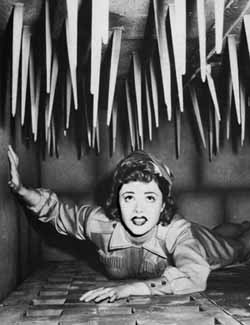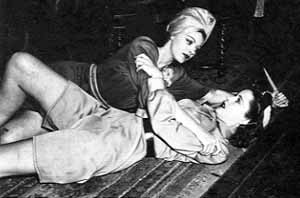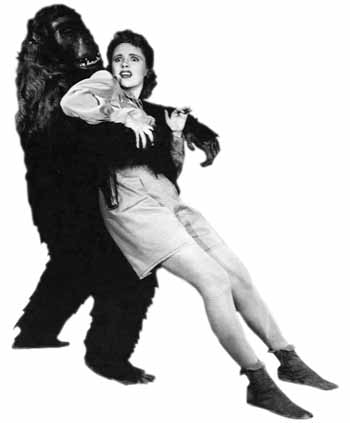|

Kay Aldridge struggles in a shrinking room
in Perils of Nyoka.
Perils of Nyoka benefitted from a slightly above-average budget, but it wasn’t the increased production values, contrary to what Jim Harmon and Donald F. Glut assert (in The Great Movie Serials, Doubleday Press, 1972), that make this serial a gem. Nyoka was made for $175,000. That’s not much more than other Republic gems like Spy Smasher, made three months before for $156,000, and The Mysterious Dr. Satan , shot in 1940, for $147,381. And there were more lavish serials—Captain America cost the studio over $220,000 in 1942—that were a clunky mess. No doubt, the Republic sheen livens up the mise-en-scene and creates a believable alternate universe, but Perils of Nyoka is a winner because of the collected imaginations of its writers and the direction of William Witney. Witney’s innovative use of close-ups, cutaways, and shot sequences invest his visuals with comic-book verve. And several of his cliffhangers and accompanying resolutions are amongst the most exciting and kinetic within the genre.
The dramatic close to Chapter Six, "Human Sacrifice," captures the rhythmic rush of comic book art. Nyoka, attempting to rescue her father, Dr. Henry Gordon—who has been hit on the head, forgotten his past and become the ruler of the evil Tauregs—is captured in a cave by the dark queen Vultura (Lorna Gray with brooding Cleopatra eyeshadowing). Nyoka, suspended by a rope, limply dangles above bubbling lava. Drums pound incessantly, anticipating the sacrifice. Witney’s rapid edits are like the alternating sizes and perspectives of comic book panels, and the dramatic parataxis of these collisions builds across time as Witney’s camera, in syncopation, crosses Nyoka’s stillness with intense close-ups of Vultura’s evil eyes and medium shots of an indifferent Professor Gordon looking on. Witney’s dramatic switches in perspectives are like alternating the dimensions of comic book panels, building tension across a penciller’s lines—Nyoka, eyes, drums, Dad. Finally, Nyoka twists, the drum pounds, and she falls into the fiery pit.
See Nyoka tortured by the evil Vultura,
an excerpt from Perils of Nyoka.
(Animated GIF, 25 frames, 150 KB)
In Chapter Seven’s resolution to the cliffhanger, Witney adds a cutaway to the rhythms and a traditional rescue gets some untraditional treatment. (SPOILERS ahead.) Larry (pre-Lone-Ranger Clayton Moore) and fellow explorer Red rush to the top of a hole outside the cave. They look down. Inside, a high-angle, point-of-view shot reveals Nyoka still limply twisting above bubbling lava. Larry and Red toss her a rope. Nyoka glances upward, and as she falls into the fire, they pull her out, because her hands are now wound around the rope. This kind of cheat, or expansion of our knowledge from the previous chapter (Larry and Red were absent but now present in the retelling of the events) may frustrate some serial novices, but for those who enjoy the rules of the genre this is a highly imaginative moment. The rope rescue, Larry and Red outside the cave looking in, is a wonderful surprise. Less imaginative cliffhangers would have had Nyoka fall and somehow miraculously miss the large fiery pit in the cave’s floor.

Nyoka battles Queen Vultura
in Perils of Nyoka.
There are several other stunning, imaginative settings that Nyoka is placed in. Stalagmites almost impale her after she falls into a hole; a collapsing Solomon-type temple nearly crushes her to death; a Poe-like swinging pendulum almost chops her in half; and an underground "water tornado" flushes her out of the cave toward apparent doom. But my favorite cliffhanger in this film is quiet and subtle. It occurs at the end of Chapter Two: "Death’s Chariot." Witney takes a six-shot cliffhanger and in the following week’s resolution expands it to seven. That one additional shot says a lot about female agency.
Between chapters two and three, Nyoka moves from possible victim to a woman-of-action. The original cliffhanger sequence has six shots: Nyoka collapsed inside a hurtling chariot; Larry riding his horse trying to stop it; long-shot, chariot rushing ahead; return to Nyoka collapsed inside; chariot point-of-view (the camera is inside it), as it careens toward the cliff’s edge; chariot over the cliff, wheels twisting in the air. The chariot point-of-view shot is the key to reading the scene. Surely, this apparently unmotivated perspective must belong to someone and can’t be the look of an inanimate object. Chapter Three’s resolution of the cliffhanger replaces shots four and five with three new shots: Nyoka waking up; Nyoka’s point-of-view of the cliff’s edge; Nyoka jumping, rolling free. This is simple film-making, but it’s also innovative—Witney’s cheat shot (his ability to close the previously absent reverse shot and reveal the character who’s looking and complete the motivation for the camera-in-the-chariot shot) makes logical sense within the previous shots’ compositions. I love it. And more importantly, Nyoka’s ability to rescue herself, to not rely on Larry and his horse, makes her a '90s woman, a sister that my daughter Caitlin applauds.
The Serials: An Introduction
Page 1: In the Theaters
Page 2: The Beginnings
Page 3: Enter Flash Gordon
Page 4: The Golden Age
Page 5: The Downfall
The Phantom Empire
Flash Gordon
Dick Tracy
The Fighting Devil Dogs
Zorro's Fighting Legion
The Shadow
Mysterious Dr. Satan
Spy Smasher
Perils of Nyoka
The Tiger Woman
Serials Web Links
|





